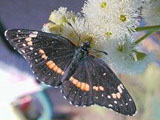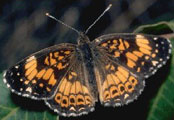Native Plants
Search for native plants by scientific name, common name or family. If you are not sure what you are looking for, try the Combination Search or our Recommended Species lists.
Rudbeckia hirta
Rudbeckia hirta L.
Black-eyed Susan, Common Black-eyed Susan, Brown-eyed Susan, Blackeyed Susan
Asteraceae (Aster Family)
Synonym(s):
USDA Symbol: ruhi2
USDA Native Status: L48 (N), AK (I), CAN (N)
Depending on growing conditions, this species may act as an annual, biennial or as a short-lived perennial. Bright-yellow, 2-3 in. wide, daisy-like flowers with dark centers are its claim-to-fame. They occur singly atop 1-2+ ft. stems. The stems and scattered, oval leaves are covered with bristly hairs. Coarse, rough-stemmed plant with daisy-like flower heads made up of showy golden-yellow ray flowers, with disc flowers forming a brown central cone.
Stems, leaves and phyllaries are covered with hairs that give it a slightly rough texture. The similar Green-headed Coneflower (R. laciniata) has yellow ray flowers pointing downward, a greenish-yellow disc, and irregularly divided leaves.
Plant Characteristics
Duration: Annual , Perennial , BiennialHabit: Herb
Size Notes: Up to about 3 feet tall.
Leaf: Green
Fruit: Fruit is a cypsela (pl. cypselae). Though technically incorrect, the fruit is often referred to as an achene.
Bloom Information
Bloom Color: Red , Orange , YellowBloom Time: Mar , Apr , May , Jun , Jul , Aug , Sep , Oct , Nov
Bloom Notes: Uniformly yellow to yellow-orange or with a basal maroon splotch.
Distribution
USA: AL , AR , CA , CO , CT , DC , DE , FL , GA , IA , ID , IL , IN , KS , KY , LA , MA , MD , ME , MI , MN , MO , MS , NC , ND , NE , NH , NJ , NM , NY , OH , OK , OR , PA , RI , SC , SD , TN , TX , UT , VA , VT , WA , WI , WV , WYCanada: AB , BC , MB , NB , NS , ON , QC , SK
Native Distribution: W. MA to Man. & WY, s. to FL & NM; widely naturalized elsewhere
Native Habitat: Prairie, Plains, Meadows, Pastures, Savannas, Woodlands' edge, Opening
Growing Conditions
Water Use: MediumLight Requirement: Sun
Soil Moisture: Dry , Moist
Soil pH: Acidic (pH<6.8)
CaCO3 Tolerance: None
Drought Tolerance: High
Soil Description: Moist to dry, well-drained soils. Juglones tolerant
Conditions Comments: The cheerful blossoms of the Black-eyed Susans liven up bouquets. This annuals may bloom longer with some afternoon shade. Birds enjoy the ripe seeds. Black-eyed Susan can become aggressive if given too perfect an environment and not enough competition.
Benefit
Use Ornamental: Color, Showy, Blooms ornamental, Wildflower meadow, Pocket prairieUse Wildlife: Nectar-Bees, Nectar-Butterflies, Nectar-insects, Seeds-Granivorous birds
Use Medicinal: Amerindians used root tea for worms, colds; external wash for sores, snakebites, swelling; root juice for earaches. (Foster & Duke)
Conspicuous Flowers: yes
Attracts: Birds , Butterflies
Larval Host: Gorgone Checkerspot, Bordered Patch butterfly
Deer Resistant: High
Butterflies and Moths of North America (BAMONA)
|
Bordered Patch (Chlosyne lacinia)  Larval Host |
Gorgone Checkerspot (Chlosyne gorgone)  Larval Host |
Propagation
Propagation Material: SeedsDescription: Propagates very easily from seed sown in fall or spring. Spring-sown seed should be stratified. Rake seed into a loose topsoil or cover with ¼ to ½ inch of soil or mulch. If possible, supplement with water if fall or spring rains are infrequent and light. The seed requires several days of moisture and should germinate in one to two weeks.
Seed Collection: The nutlets turn charcoal-gray at maturity, usually 3-4 weeks after the bloom period. Seeds are mature at this time, but they are easier to collect after cones lose their tight compact stucture. Store dry in sealed, refrigerated containers.
Seed Treatment: Stratify for 3 months at 40 degrees.
Commercially Avail: yes
Maintenance: Black-eyed Susans are drought tolerant but respond well to an occasional watering. Additional irrigation in a dry year will improve the density of the stand and lengthen the flowering season. Do not mow until after the plants have formed mature seed cones, about three to four weeks after flowering. (Check by breaking a cone open and if the seeds are dark, they are mature.) The number of volunteer plants can be limited by removing the seed heads after the flowers are done.
Find Seed or Plants
Order seed of this species from Native American Seed and help support the Wildflower Center.
Find seed sources for this species at the Native Seed Network.
View propagation protocol from Native Plants Network.
Mr. Smarty Plants says
Native plants for shady small spaces in Houston, TX
June 18, 2006
What are the best plants and flowers to plant in small spaces in an urban area in Houston, Texas? I have several flower beds that are 3 foot wide and 10-12 foot long that get half day sun. The area...
view the full question and answer
Native, non-invasive plant seeds for each region in U.S.
June 09, 2006
I need to identify a wildflower from each region that we can package in custom packaging to use as giveaways at our member zoos and aquariums. Our project this year is called Conservation Made Simple...
view the full question and answer
National Wetland Indicator Status
| Region: | AGCP | AK | AW | CB | EMP | GP | HI | MW | NCNE | WMVE |
| Status: | FACU | FACU | FACU | FACU | FACU | FACU | FACU |
From the National Organizations Directory
According to the species list provided by Affiliate Organizations, this plant is on display at the following locations:Fredericksburg Nature Center - Fredericksburg, TX
Lady Bird Johnson Wildflower Center - Austin, TX
Native Plant Center at Westchester Community College, The - Valhalla, NY
Texas Discovery Gardens - Dallas, TX
Brackenridge Field Laboratory - Austin, TX
United States Botanic Garden - Washington, DC
Crosby Arboretum - Picayune, MS
Texas Parks and Wildlife Department - Austin, TX
NPSOT - Fredericksburg Chapter - Fredericksburg, TX
NPSOT - Austin Chapter - Austin, TX
Native Seed Network - Corvallis, OR
Jacob's Well Natural Area - Wimberley, TX
NPSOT - Williamson County Chapter - Georgetown, TX
Herbarium Specimen(s)
NPSOT 0400 Collected Jun 1, 1993 in Comal County by Mary Beth WhiteNPSOT 0555 Collected Jun 26, 1988 in Bexar County by Harry Cliffe
NPSOT 0010 Collected April 25, 1990 in Bexar County by Judith C. Berry
NPSOT 0064 Collected May 19, 1990 in Bexar County by Lottie Millsaps
Wildflower Center Seed Bank
LBJWC-8 Collected 2006-05-24 in Travis County by Lady Bird Johnson Wildflower CenterBibliography
Bibref 417 - Field Guide to Medicinal Plants and Herbs of Eastern and Central North America (2000) Foster, S. & J. A. DukeBibref 1186 - Field Guide to Moths of Eastern North America (2005) Covell, C.V., Jr.
Bibref 1185 - Field Guide to Western Butterflies (Peterson Field Guides) (1999) Opler, P.A. and A.B. Wright
Bibref 1620 - Gardening with Native Plants of the South (Reprint Edition) (2009) Wasowski, S. with A. Wasowski
Bibref 946 - Gardening with Prairie Plants: How to Create Beautiful Native Landscapes (2002) Wasowski, Sally
Bibref 355 - Landscaping with Native Plants of Texas and the Southwest (1991) Miller, G. O.
Bibref 318 - Native Texas Plants: Landscaping Region by Region (2002) Wasowski, S. & A. Wasowski
Bibref 248 - Texas Wildflowers: A Field Guide (1984) Loughmiller, C. & L. Loughmiller
Bibref 291 - Texas Wildscapes: Gardening for Wildlife (1999) Damude, N. & K.C. Bender
Bibref 1294 - The Midwestern Native Garden: Native Alternatives to Nonnative Flowers and Plants An Illustrated Guide (2011) Adelman, Charlotte and Schwartz, Bernard L.
Bibref 328 - Wildflowers of Texas (2003) Ajilvsgi, Geyata.
Bibref 286 - Wildflowers of the Texas Hill Country (1989) Enquist, M.
Search More Titles in Bibliography
Web Reference
Webref 38 - Flora of North America (2019) Missouri Botanical Garden, St. Louis, MO & Harvard University Herbaria, Cambridge, MA.Webref 23 - Southwest Environmental Information Network (2009) SEINet - Arizona Chapter
Research Literature
Reslit 259 - Experimental restoration of native vegetation in Indiana Dunes National Lakeshore (1998) Y. D. Choi and N. B. PavlovicReslit 102 - Age of maturity and life span in herbaceous, polycarpic perennials (2000) M. H. Bender, J. M. Baskin and C. C. Baskin
Reslit 106 - Native wildflower establishment with imidazolinone herbicides (1999) D. D. Beran, R. E. Gaussoin and R. A. Masters
Reslit 128 - Intermittent Light from a Rotating High-pressure Sodium Lamp Promotes Flowering of Long-day Plants (2010) M. G. Blanchard and E. S. Runkle
Reslit 343 - Weed control in container grown herbaceous perennials (1994) J. F. Derr
Reslit 558 - Direct and indirect effects of herbivory: Feeding by spittlebugs affects pollinator visitation rates and seedset of Rudbeckia hirta (2001) P. A. Hamback
Reslit 569 - Anatomical changes in Rudbeckia hirta L during transition to flowering (1993) R. L. Harkess and R. E. Lyons
Reslit 570 - Gibberellin-induced and cytokinin-induced growth and flowering responses in Rudbeckia hirta L. (1994) R. L. Harkess and R. E. Lyons
Reslit 571 - Floral initiation in Rudbeckia hirta (Asteraceae) under limited inductive photoperiodic treatments (1994) R. L. Harkess and R. E. Lyons
Reslit 600 - Performance of selected herbaceous annual ornamentals grown at decreasing levels of irrigation (2006) D. Y. Henson, S. E. Newman and D. E. Hartley
This information was provided by the Florida WIldflower Foundation.
Search More Titles in Research Literature
From the Archive
Wildflower Newsletter 1985 VOL. 2, NO.1 - A Glorious Spring, Lupines in Landscapes, Director's Report, Notable Quote, Wild...Wildflower Newsletter 1985 VOL. 2, NO.2 - Guide to Black-Eyed Susan, Parkways, Wildflowers for the East, Arboretum Mall to...
Wildflower Newsletter 1987 VOL. 4, NO.3 - Fall Planting Highlights the Season, Jubilee Celebration Commences December 1987...
Wildflower Newsletter 1987 VOL. 4, NO.4 - Wildflower Center Sows Seeds for the Country, Hotline for Texas, New Goals Plans...
Wildflower Newsletter 1990 VOL. 7, NO.5 - Naturalistic Landscaping Takes Careful Planning, Director\'s Report, Breaking th...
Wildflower Newsletter 1994 VOL. 11, NO.6 - Wildflower Center Featured Non-Profit in Neiman Marcus Christmas Book, Dana Leav...
Wildflower Newsletter 1995 VOL. 12, NO.2 - Wildflower Center Opens April 8th through 9th, Grand Opening Schedule of Events,...
Additional resources
USDA: Find Rudbeckia hirta in USDA PlantsFNA: Find Rudbeckia hirta in the Flora of North America (if available)
Google: Search Google for Rudbeckia hirta
Metadata
Record Modified: 2023-01-13Research By: TWC Staff